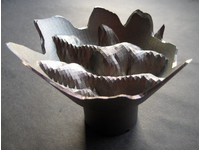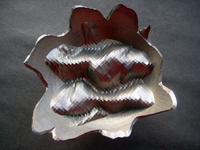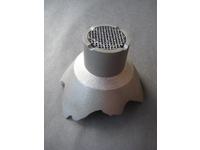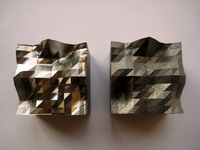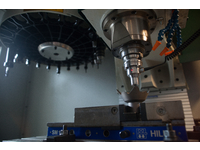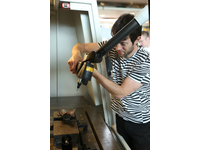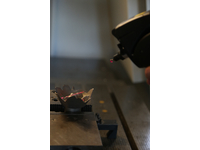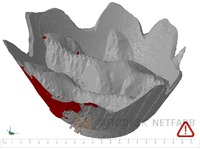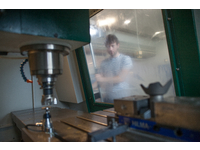Hybrid Digital Manufacture of Titanium artifacts
Masterton, Drummond  ORCID: https://orcid.org/0000-0002-4860-9494
(2015)
Unobtainium.
[Artwork]
ORCID: https://orcid.org/0000-0002-4860-9494
(2015)
Unobtainium.
[Artwork]
| Item Type: | Artwork |
|---|---|
| Creators: | Masterton, Drummond |
| Corporate Creators: | Renishaw, Hexagon Metrology |
| Abstract / Summary: | This practice based research project is a business collaboration supported by Renishaw and Hexagon Metrology which aims to explore the creative application of Additive Manufacturing technologies. The research will fuse additive and subtractive technologies in order to develop innovative solutions to increase the level of control over form and surface patterning of 3D printed metal objects. Renishaw (Est. 1973) is a UK global company with core skills in measurement, motion control, spectroscopy and precision machining. Renishaw’s products are used in applications as diverse as co-ordinate measurement, CAD/CAM dentistry, shape memory alloys and Additive Manufacturing. Additive Manufacturing (AM) is a term used to describe a range of processes which are capable of producing functional components or products in materials such as nylon, titanium, steel and some precious metals. AM is a development of Rapid Prototyping (RP) technology and is forecasted to supersede some traditional subtractive processes of manufacturing due to its ability to create complex geometries including internal structures and to reduce waste. The main applications for this developing technology are light weighting of components in aerospace and automotive and medical applications such as dental and cranial braces. Selective Laser Melting (SLM) is a new Additive Manufacture technology which has been developed by Renishaw, it is unique in the level of accuracy and surface detail that it can produce directly in metal. Craft practitioners and designers have started to explore the creative application of these processes, Lionel Dean, Michael Eden, Nervous systems and Freedom Of Creation have all exploited these technologies to develop objects. Much of this work is limited to the creative application of the SLS and SLM manufacturing process and the new geometries it can enable; there remain opportunities to explore innovation through more direct engagement with the process and propriety software used to process files into an understandable format. The sub-contract model used to access such technology is problematic as it prevents craft practitioners from achieving exclusive control of the end aesthetic by requiring an intermediary (often a software engineer) to interpret their ideas; often this process has an overweighing influence on the final look and aesthetic language of the object. One of the major barriers of AM for the creative industries and individual craft practitioners is the limited range and control of surface quality; my project will address both of these issues. My practice is unique in the field of digital craft in that it seeks to engage with every part of the process to find innovative opportunities for new creative engagement. I have developed this unique practice due to the level of access of Falmouth’s unprecedented digital resources. ‘Unobtanium’ is a reference to my interest in military and bicycle manufacturing. Skunk Works, a branch of Lockheed who designed the SR -71 Blackbird spy plane used the term to refer to the metal (Titanium) which had been purchased from the Russians to build a supersonic spy plane. Sunglass manufacturer Oakley used the term in their advertising during the 90’s to highlight the level of innovation in their lense design and coatings. Aims • To create a showcase artefact for exhibition at Collect 2015 using advanced digital manufacturing processes at Renishaw and Falmouth University. The artefact will explore my interests of landscape and topology while demonstrating and expanding my acknowledged reputation for crafting innovative digital craft. • To develop a new hybrid prototyping process that will offer the potential to blend the unique advantages of Additive Manufacture and CNC milling. • To explore opportunities to commercialise any innovation on the above process with Renishaw • To disseminate the project learning through a paper, conference, documentation or public talk Objectives • I will develop physical test pieces and objects which reflect on ideas of landscape and topology. The use of both additive and reductive digital manufacturing processes will enable the design and manufacture of complex 3D geometries with highly detailed surface patterning. This fusion will balance the unique visual signatures of each process to create a new digital aesthetic. • To develop an indepth understanding of the unique process of Selective Laser Melting through collaborative dialogue with engineers at Renishaw • To develop an indepth knowledge of the specialist software module, Space structures. • To identify and explore opportunities for creative engagement, risk taking and play with software and hardware processes. • To test and develop a range of holding and alignment processes in order to accurately mill SLM parts • To develop a range of patterning and texture samples through CNC and Laser milling. • To develop an understanding of the particular machining qualities of different Titanium alloys with input from the CNC milling department at Renishaw. • To develop an understanding of a range of finishing process on titanium • To document and write reports on each stage of the project • To exhibit the project outcome at the International craft exhibition, Collect, Saatchi gallery in London, May 2015. |
| Date: | 8 May 2015 |
| Uncontrolled Keywords: | 3D Printing, Hybrid Manufacture, Near Net Forming, 3D Laser Scanning |
| Subjects: | Creative Art & Design Computing & Data Science |
| Department: | School of Architecture, Design & Interiors |
| Depositing User: | Drummond Masterton |
| Date Deposited: | 07 Mar 2017 16:52 |
| Last Modified: | 18 Nov 2024 14:25 |
| URI: | https://repository.falmouth.ac.uk/id/eprint/2453 |
 |
View Record (staff only) |

 Advanced Search
Advanced Search Tools
Tools Tools
Tools